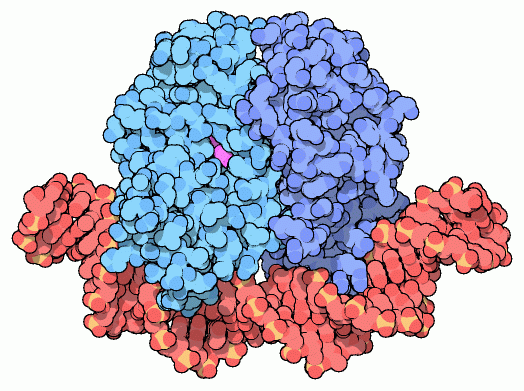|
Inhaltsübersicht | Nanomaschinen | Moleküle | Programme | Kurse | Fun | Links |
||
| > |
Catabolite Activator Protein

Sweet Tooth
Bacteria love sugar. In particular, bacteria love glucose, which is easily digestible and quickly converted to chemical energy. When glucose is plentiful, bacteria ignore other nutrients in their environment, feasting on their favored source. But, when glucose is rare, they shift gears and mobilize the machinery needed to use other sources of energy.Second Messengers
Bacteria use an unusual modification of ATP, the molecule that carries chemical energy in the cell, to notify its synthetic machinery about what it is currently eating. As glucose levels drop, the cell-surface enzyme adenyl cyclase is activated. It grabs ATP molecules, clips off two phosphates, and reconnects the free end back onto the molecule, creating an odd little molecular loop through the phosphate. This product, called cyclic AMP, is released and it spreads through the cell, stimulating production of the enzymes that process other food molecules. Because of its role in delivering messages from the primary glucose sensor (adenyl cyclase) to the synthetic machinery, cyclic AMP is often known as a second messenger.Reading the Message
Catabolite activator protein (CAP), also known as cyclic AMP receptor protein (CRP), is activated by cyclic AMP and stimulates synthesis of the enzymes that break down non-glucose food molecules. It is composed of two identical subunits, shown here in blue from PDB entry 1cgp. When cyclic AMP (shown in purple) binds, it changes the conformation of the protein slightly, making it perfect for binding to DNA (shown here in red). CAP binds to a specific DNA sequence, which is found next to the genes that are activated. As we will see on the next page, when CAP binds to DNA, it coaxes RNA polymerase into place, beginning transcription.Get a Grip
CAP is not gentle when it binds to DNA: it grabs the DNA and bends it by nearly 90 degrees. This is not a smooth bend, however. Since DNA is a double helix with two grooves that spiral up along the strand, it bends more easily in some directions. CAP bends the DNA sharply at two positions where protein alpha helices contact the compressible DNA major groove.Next: CAP in Action
Last changed by: A.Honegger,